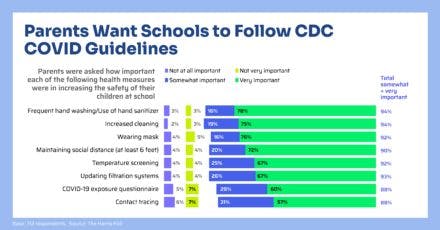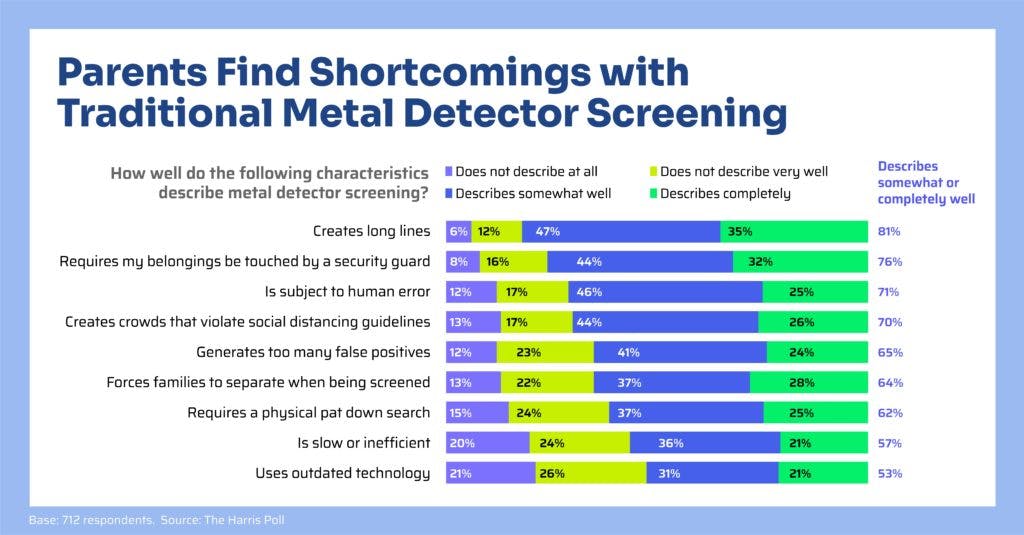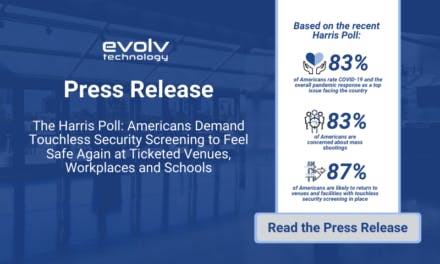Harris Poll Shows Physical Security is Crucial to Getting Kids Back in School
Parents are equally concerned about mass shootings and COVID; the majority want weapons screening in place.
While effectively dealing with COVID-19 is top-of-mind for facilities managers as they work toward getting students back to school full-time, a recent Harris Poll we commissioned indicates there’s significant concern over violence and crime to be overcome as well. And in the COVID era, traditional screening methods that create lines and crowding will no longer be acceptable as a mitigation measure.
For the poll, more than 700 parents of K-12 school-aged children were surveyed in Sept. and Oct. 2020. It found 87% of the parents were either very or somewhat concerned about their kids contacting COVID upon returning to school. But concern over their physical security was a close second, at 81%. Although parents in urban areas were more likely to be somewhat or very concerned than their suburban counterparts, over half of suburban parents are concerned about the physical security of their children, 74% vs. 54%, respectively.
Eight out of ten parents are concerned about the physical security of their school age children.
COVID measures yes, but physical security, too
It’s a similar story when looking at COVID-19 prevention protocols and measures to ensure physical safety.
Having schools follow federal Centers for Disease Control and Prevention (CDC) protocols is important to parents feeling safe about their kids. More than 90% of parents say it’s important for schools to ensure frequent handwashing and sanitizing, increased cleaning, mask wearing, social distancing and temperature screening (see Figure 1).
Figure 1

While that is certainly understandable, what may be surprising is that parents are nearly as concerned over physical security measures intended to keep students safe. More than 9 in 10 parents said it was somewhat or very important that each of the following measures be in place:
- Locked doors and visitors showing ID: 92%
- Presence of law enforcement: 92%
- All classrooms have door locks: 91%
- Metal detector for screening: 91%
Over 90% of parents say it is important to have a metal detector to screen for weapons coming into schools.
Part of the reason for concern over physical security measures is a fear of violence in public spaces. Sadly, school safety has been an issue for decades now. But concern seems to be growing, as the poll found 68% of parents think the risk is higher now than a year ago. Perhaps even more concerning, more than a third (31%) say going out in public is “mostly” or “very” unsafe.
Almost 90% of parents are concerned about a mass shooting in schools, matching the same level of concern about COVID.
In fact, parents are just as concerned over the risk of various sorts of physical violence as they are of COVID. Indeed, 88% of parents are somewhat or very concerned about COVID, the exact same number as for mass shootings. The numbers are similar for other forms of threats:
- Protest-related civil unrest/violence: 86%
- Street crime: 83%
- Terrorism: 76%
COVID-related issues with metal detectors
So, it’s clear schools will have to take steps to assuage parents’ concerns over various physical threats. But the poll makes clear the pandemic is making that more challenging.
Parents now see issues with traditional metal detector screening. More than three quarters of parents are concerned that screening can create long lines and requires a student’s belongings to be touched by a security guard (see Figure 2). Fewer but still significant numbers of parents cite issues such as the possibility for human error, creating crowds that violate social distancing guidelines, and the need for physical pat-downs and searches.
Figure 2

The poll makes clear any schools using traditional metal detector screening are in for some backlash from parents. In the COVID era, at least half of parents are not willing to accept many of the problems associated with traditional metal detectors, including:
- Crowds that violate social distancing guidelines
- Use of outdated technology
- False positives
- Slow or inefficient processes
- Physical pat down searches
Three out of four parents are concerned that security screening creates lines, and two thirds of them would not join a line that lacked social distancing.
Here’s another stat from the poll that I found fairly astounding: When parents were asked what they would do if they saw a security line in which people were not socially distancing, nearly two-thirds (65%) said they would not join the line. This inclination was far more pronounced in urban (73%) and suburban (64%) areas than rural (43%).
A touchless screening experience
I discussed this issue, along with many others, in a webinar with Erica Parker, Managing Director at The Harris Poll. “When you think about the intersection of COVID and metal detector screening, and the fact that it can create long security lines, [parents are] not interested in that,” she said. Newer technology can make a difference, though. “We find that 87% are likely to return to facilities and venues if there was a touchless security screening,” she said.
The vast majority of parents (87%) say they are likely to return to facilities and venues if touchless security screening is in place.
That makes sense because newer touchless security screening systems create an altogether different experience. There’s no need to empty pockets, because the system can detect items that are in your pockets and differentiate, say, a gun from a metal keychain or phone. By the same token, you can carry bags through the screener; there’s no need to empty them out. The systems are reliable enough that there are far fewer false positives – meaning mistaking a harmless item for a weapon – which means there’s no need for pat-downs.
All of these attributes contribute to another big advantage of touchless systems: they’re much faster. Evolv Express, for example, uses artificial intelligence and powerful sensors to screen up to 3,600 people per hour, about 10 times faster than legacy metal detectors.
New back to school requirements
The Harris Poll makes clear that while COVID-19 is a top concern for parents of K-12 students, their physical safety is a close second. But given the COVID requirements for social distancing, it’s equally clear that we need to investigate new ways to keep kids safe and secure.
Parents will appreciate schools that implement a touchless approach, as 85% of them agree that knowing everyone is screened upon entering a school building makes them more comfortable. And more than three quarters (78%) agreed that metal detection systems make it impossible to socially distance while in line.
With a system like Evolv Express, you can get ahead of the curve and safely welcome kids back to school. To learn more, visit Evolv.
